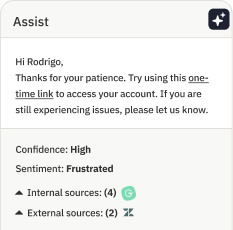What is BPO? Plus FAQs about scaling your customer support operations

When did you realize your support team had “made it?”
Maybe it was the first time you received several rave reviews from customers in a single week. Maybe it was getting to the point when 24/7 customer service was possible. Or maybe it was when you came to the conclusion that your team is now a true department rather than a side project.
No matter what your moment of realization was, it helped you recognize that your customer support team successfully transitioned from a scrappy operation to a high-functioning department. That’s a huge accomplishment — let it sink in.
It’s exciting to lead a growing team because it means there are more meaningful milestones ahead. But as your team continues to expand, you’ve also probably realized that you need to start thinking about how you can future-proof your support team to ensure sustainable growth and maintain high customer service standards.
If you’ve done any preliminary research on how to scale your support team, you’ve likely come across a strategy called business process outsourcing, commonly called BPO. Let’s take a closer look at what exactly BPO is, how it works, and most importantly if it makes sense for your customer support operations.
What is BPO?
The term itself sounds like a mouthful, so just what is business process outsourcing? Kustomer explains that it’s essentially using external experts to help build your business or processes.
While BPO has been looked down upon in the past, it’s actually a great option for businesses that need a tailored solution to meet their needs. Done right, BPO can improve a company’s efficiency, drive cost savings, and even reinforce the values your team already has in place.
So, how did BPO come about? It really started in the manufacturing industry. Companies found that by outsourcing certain functions to third-party vendors, they were able to scale better. Consider the history of Coca-Cola. The iconic brand began establishing relationships with bottlers in other countries back in the 1920s and 1930s. Over time, the company continued to expand its footprint and grow into the multinational brand it is today.
While BPO may have started in manufacturing, it’s easy to see how the model applies to other types of businesses and even specific functions. In fact, BPO is used for many different types of processes including:
- Accounting
- IT Services
- Human Resources
- Customer Support
- Payroll
Business process outsourcing is also more common than you might expect. Believe it or not, it’s not just behemoth companies that rely on BPO to scale their operations. According to a survey of small businesses, 37% of respondents say they already outsource at least one process. It just so happens that 24% of those companies have chosen to leverage a third-party vendor to grow their customer support operations.
.png)
How does business process outsourcing work?
Let’s get to the nitty-gritty: how does BPO work in practice? There’s a pretty big transition to go from managing your in-house team to managing a BPO vendor. It takes a lot of up-front planning and excellent communication (more on that later), but once your BPO relationship is up and running, the vendor will take the services you contracted them for off your plate. Remember, you set the terms, so you can be as hands-on or hands-off as you want.
As for what that involves, think of the types of tasks your support team is responsible for. This looks a bit different for every organization, but Zendesk highlights three primary types of customer support activities — one that’s higher in complexity and lower in volume, and two that are the opposite — and they can all be supported by BPO.
1. Product or technical issues
When you have a huge volume of customers calling in with complex problems that require a lot of explanation, agents can quickly find themselves overwhelmed. You can end up with long hold times, not to mention stressed agents.
Business process outsourcing helps to ensure you have a reliable team of agents at the ready. While agents who work for the BPO vendor won’t necessarily have all the answers, you can head off issues by providing well-documented resources, such as a knowledge base. Successfully pulling this off requires both starting and maintaining an accurate database where agents can find all the information they need to resolve customer issues.
2. Order processing
Even in today’s digital world, some customers prefer to make purchases over the phone. This type of support isn’t complex, but it is tedious. Processing these orders can suck up time that could otherwise go toward more valuable work.
One thing to keep in mind when it comes to BPO is that you can pick and choose what you want to outsource versus what you want to keep in-house. In this scenario, outsourcing order processing and similarly simple requests can free your agents to work on the more complex cases mentioned above.
3. Upgrade or renewal requests
Companies that offer subscription-based products or services — that includes everything from weekly snack boxes to annual software licenses — often receive calls from customers looking to renew or even upgrade. Sometimes support agents transfer the customer to a sales agent, but they can also be trained to help a customer with this request.
This is another example where you could use some help from a BPO vendor to take care of a relatively straightforward request and give your in-house agents some breathing room.
What are the different types of BPO?
As you might have guessed, there are a lot of options when it comes to choosing a third party for business process outsourcing. There are three main types, which are really based on where your company and the BPO vendor are located.
- Onshore (or local) outsourcing — This would be a company located in the same country as your business, whether the distance is 2 or 200+ miles.
- Offshore outsourcing — An offshore BPO is a company that’s located in a different country than where your business is.
- Nearshore outsourcing — While very similar to offshore outsourcing, this entails working with a vendor in a neighboring country. So if your company is located in the U.S., working with a BPO vendor in Mexico would be considered nearshore outsourcing.
Offshore customer support is often the most cost-effective way to scale support, and it can even make 24/7 operations a possibility for companies that previously had limited hours for their support team. On the other hand, there are regulations, technology differences, and cultural nuances to be aware of. The takeaway is to do plenty of research before making a decision on any particular type of BPO location.
Do you need BPO or should you scale your own team?
Business process outsourcing might be a go-to method for support operations, but it’s also not the only option. For some companies, scaling their in-house team by hiring more full-time and part-time agents is actually a better option.
If your support team includes just a handful of agents, hiring more employees is definitely the way to go for now. You’ll have full control over their training and can make sure every new hire you bring on is a great fit for your awesome company culture.
This doesn’t mean in-house teams are without challenges. But if your issues are primarily surrounding scheduling and forecasting, it may be that you need to start by leveraging a more robust workforce management tool. Implementing some sort of workforce management software also ensures you’ll be able to retain control should you make the transition to BPO because you can integrate the vendor into that system.
And remember, “in-house” doesn’t mean agents have to physically be present in your office headquarters. More and more support teams are staffed partially or even entirely by remote support agents. As long as you maintain clear expectations, provide the right systems, and check in with your team members proactively, you can manage a remote support team just as effectively as one that’s based on-site.
But what if your support team is starting to face some more significant obstacles now that it’s getting larger? How do you know whether outsourcing is a good option for you? Consider both the pros and cons of BPO.
.png)
Advantages of BPO
There are some undeniable advantages of business process outsourcing, and Deloitte’s 2020 Global Outsourcing Survey spells them out pretty clearly. According to the survey, cost is the primary reason companies choose to outsource.
Not only does BPO allow cost savings in the form of lower wages, but it also eliminates the upfront costs associated with recruiting and onboarding new in-house agents.
Outsourcing also allows you to offload repetitive administrative tasks so you and your team can focus on more complex problems. Lastly, it’s a natural step toward expanding your operations to other countries. If you have lofty goals of going global, partnering with a BPO vendor in another country helps you test the waters a bit.
Disadvantages of BPO
You’d be wise to be at least a bit skeptical about the outsourcing route because there are some potential downsides to BPO that you should be cautious of.
One disadvantage is there’s always the risk of a data breach that could expose your customers’ information. There can also be quality issues that negatively affect the customer experience if you don’t devote enough time and energy to training and regularly checking in with the vendor you choose.
In some cases, customers may also have a negative perception of a company that leverages a BPO vendor. This is especially true if their conversations with agents employed by the BPO vendor don’t match up to their previous experiences.
There’s also a certain amount of unknown when you decide to outsource customer support, but there are a few ways you can ensure better visibility and control. By integrating the BPO vendor into your workforce management system, you can regain some of that visibility. You can also put a few safeguards in place, such as only paying for productive hours or the number of tickets solved, to ensure the BPO is truly meeting your needs.
How can you get started with BPO?
Maybe you’re starting to feel that BPO is a good choice for your support operations. Figuring out how to get started can feel a bit overwhelming, but just take it one step at a time. Finding a BPO partner isn’t something you want to rush.
Think about whether you want to partner with an offshore, onshore, or nearshore vendor, and then dig into researching. Once you’ve identified some good BPO options, consider some specifics. When choosing a BPO, you’ll want to take into account culture fit, whether the BPO is genuinely interested in improving your business, and what types of tools they have in place.
Even after making a selection, there’s a lot of work to be done. The actual transition can be tricky and you want to get it right. Research from Accenture shows that effective change management — involving everything from extensive documentation to clear communication to restructuring your company — sets the stage for a successful BPO relationship.
Thinking about the entire transition is pretty overwhelming, so consider whether it’s possible to bring on a person or team dedicated to BPO management (something many companies do). It also helps to think about some smaller steps. There are several to-do items that can help you take the right approach to scaling your support team with BPO.
✅ Provide upfront training to make sure your vendor understands your business and how they should represent it with customers.
✅ Communicate new products and features as they roll out to make sure agents are always in the know.
✅ Implement a quality assurance program that allows you to track performance and identify opportunities for improvement.
✅ Have back-up plans that agents can rely on when they’re caught off-guard by a question or when mother nature keeps agents from going into the office as they normally would.
The more planning and preparation you do at the outset, the better your chances of a seamless transition to outsourcing customer support.
And remember that BPO doesn’t have to be all or nothing. Maybe you simply need to start with off-hours support when your agents aren’t in the office. Or maybe you could benefit from support with just one or two particular types of requests. You might be surprised at how taking administrative tasks off your agents’ plates frees them to provide exceptional customer service where it’s truly needed.
Strategically scale your support team
Your team is growing and proving every day that they really care about ensuring customers have the best possible experience. For you, as the leader of this mighty team, it’s an exciting time. Not only do you get to work with great team members, but you also have the opportunity to do work that directly impacts the entire company.
That isn’t to say support is all sunshine and rainbows. There are certainly some tough decisions you’ll have to make, including deciding whether to scale in-house or go the BPO route, but it’s nothing beyond what you can handle. And now that you know more about what business process outsourcing is, you might even feel ready to tackle your next challenge.
Find out how some of the top workforce management leaders navigate support challenges at every point of scale.





